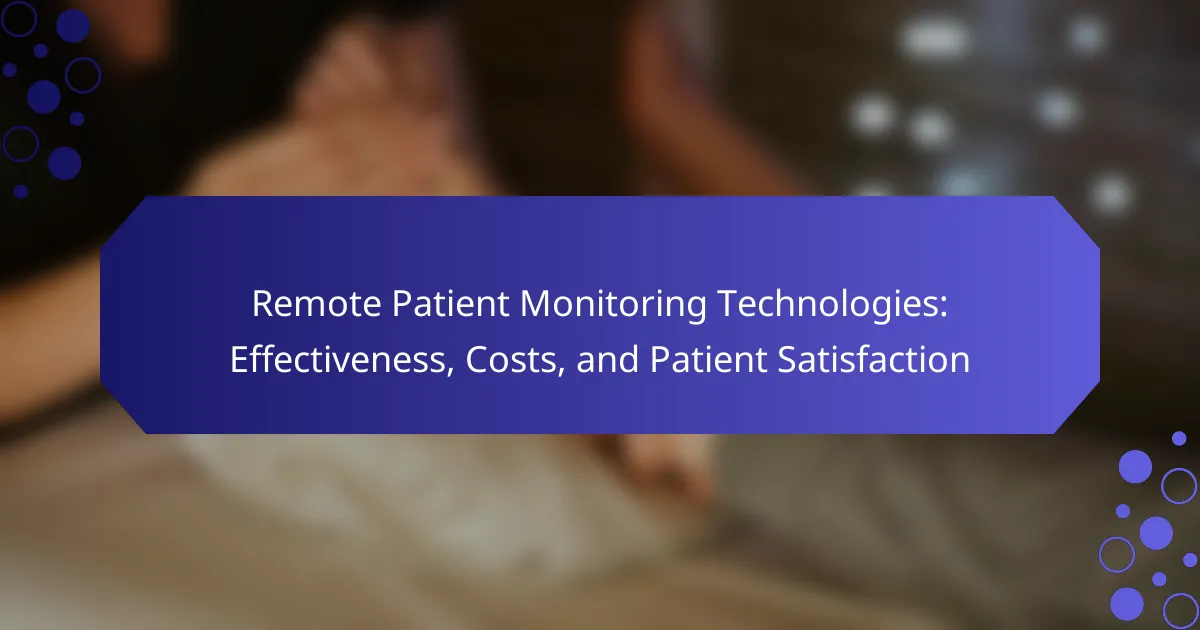Remote Patient Monitoring Technologies enhance healthcare delivery by improving patient outcomes, reducing costs, and increasing satisfaction. This article explores the effectiveness of these technologies, their associated costs, and the impact on patient satisfaction. Key components include wearable sensors, mobile applications, and secure cloud platforms. Additionally, we will examine challenges faced by healthcare providers and the role of regulatory frameworks in shaping these innovations.
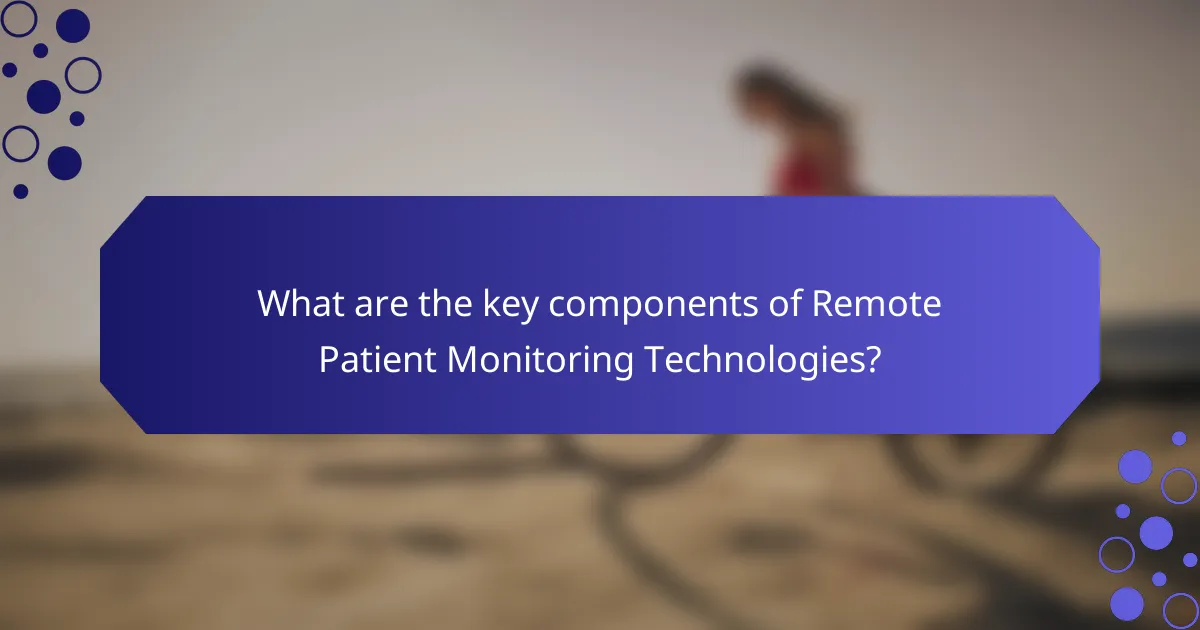
What are the key components of Remote Patient Monitoring Technologies?
Remote Patient Monitoring Technologies primarily consist of devices, software, and communication systems that facilitate health data collection and transmission. Key components include wearable sensors that track vital signs, mobile applications for data management, and secure cloud platforms for data storage and analysis. These technologies enhance patient engagement, improve chronic disease management, and reduce healthcare costs. Advanced analytics and AI integration further optimize patient outcomes by providing actionable insights based on real-time data.
How do these technologies collect patient data?
Remote patient monitoring technologies collect patient data through various methods, including wearable devices, mobile applications, and remote sensors. These technologies utilize real-time data transmission to track vital signs, activity levels, and medication adherence. For instance, wearable devices can continuously monitor heart rate and blood pressure, while mobile applications facilitate self-reporting of symptoms and health metrics. This data is securely transmitted to healthcare providers, enabling timely interventions and personalized care plans. As a result, patient engagement and health outcomes improve significantly.
What types of devices are commonly used in remote monitoring?
Common devices used in remote monitoring include wearable sensors, mobile health applications, and telehealth platforms. These technologies enable continuous health tracking and data collection. Wearable sensors, such as smartwatches and fitness trackers, monitor vital signs and physical activity. Mobile health applications facilitate patient engagement and communication with healthcare providers. Telehealth platforms support virtual consultations and remote diagnostics. Each device enhances patient care and contributes to effective remote patient monitoring.
Which software platforms support remote patient monitoring?
Several software platforms support remote patient monitoring, including Teladoc Health, Philips HealthSuite, and Medtronic Care Management Services. These platforms provide tools for tracking patient data, enhancing communication, and improving health outcomes. Additionally, platforms like MyChart and HealthLoop offer user-friendly interfaces for both patients and providers. Each platform varies in features, integration capabilities, and costs, influencing their effectiveness in different healthcare settings.
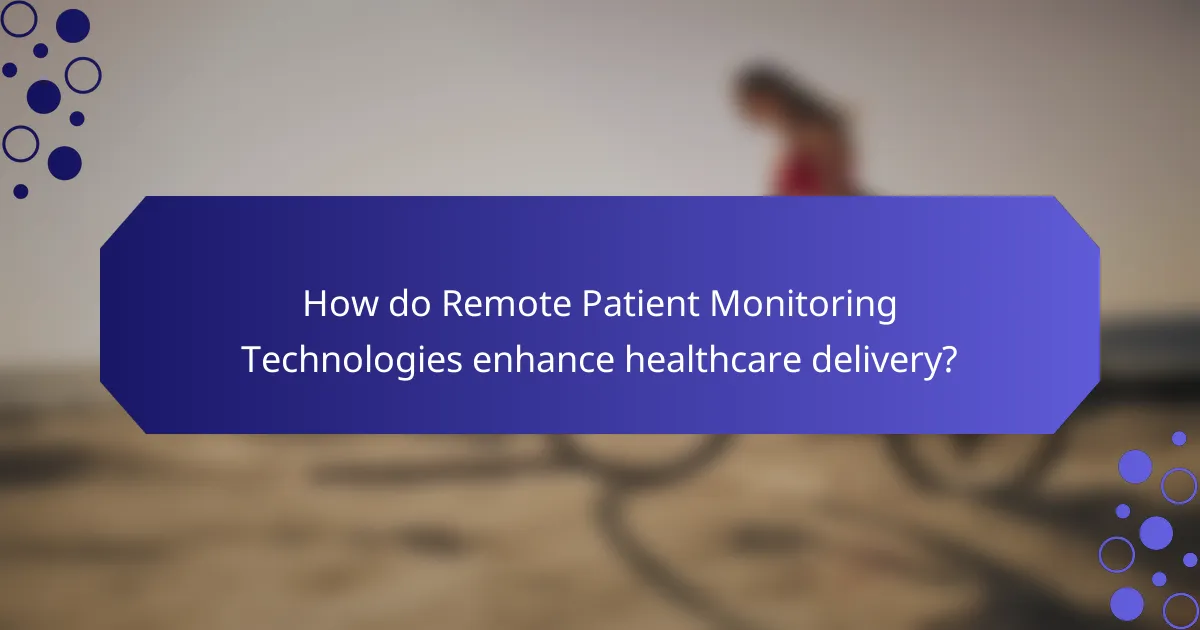
How do Remote Patient Monitoring Technologies enhance healthcare delivery?
Remote Patient Monitoring Technologies significantly enhance healthcare delivery by improving patient outcomes, reducing costs, and increasing satisfaction. These technologies enable continuous health monitoring, allowing for timely interventions and personalized care.
Data shows that remote monitoring can decrease hospital readmission rates by up to 30%, demonstrating its effectiveness in managing chronic conditions. Additionally, patients using these technologies report higher satisfaction levels, with 85% expressing a preference for remote consultations over traditional visits.
Cost-effectiveness is another key attribute, as remote monitoring can lower healthcare expenses by reducing unnecessary hospital visits. Overall, these technologies streamline healthcare delivery, making it more efficient and patient-centered.
What are the primary benefits of using these technologies for patients?
Remote patient monitoring technologies significantly enhance patient care by improving health outcomes, reducing costs, and increasing satisfaction. These technologies enable continuous health tracking, allowing for timely interventions and personalized care. As a result, patients experience fewer hospitalizations and better management of chronic conditions. Moreover, studies show that patient satisfaction increases due to the convenience and accessibility of remote monitoring, fostering a sense of empowerment in managing their health.
How do healthcare providers benefit from remote monitoring?
Healthcare providers benefit from remote monitoring by enhancing patient care, reducing costs, and improving operational efficiency. These technologies enable real-time health tracking, allowing for timely interventions. As a result, providers can achieve better patient outcomes and increased satisfaction. Remote monitoring can lead to a 30% reduction in hospital readmissions, demonstrating its effectiveness in chronic disease management. Additionally, it decreases the need for in-person visits, saving time and resources for both patients and providers.
What role does remote monitoring play in chronic disease management?
Remote monitoring significantly enhances chronic disease management by enabling continuous health data collection. This technology facilitates timely interventions, improves patient engagement, and reduces hospital visits. Studies show that remote monitoring can lower healthcare costs by up to 20% while increasing patient satisfaction rates. Furthermore, it allows healthcare providers to tailor treatment plans based on real-time data, ensuring better health outcomes for patients with chronic conditions.
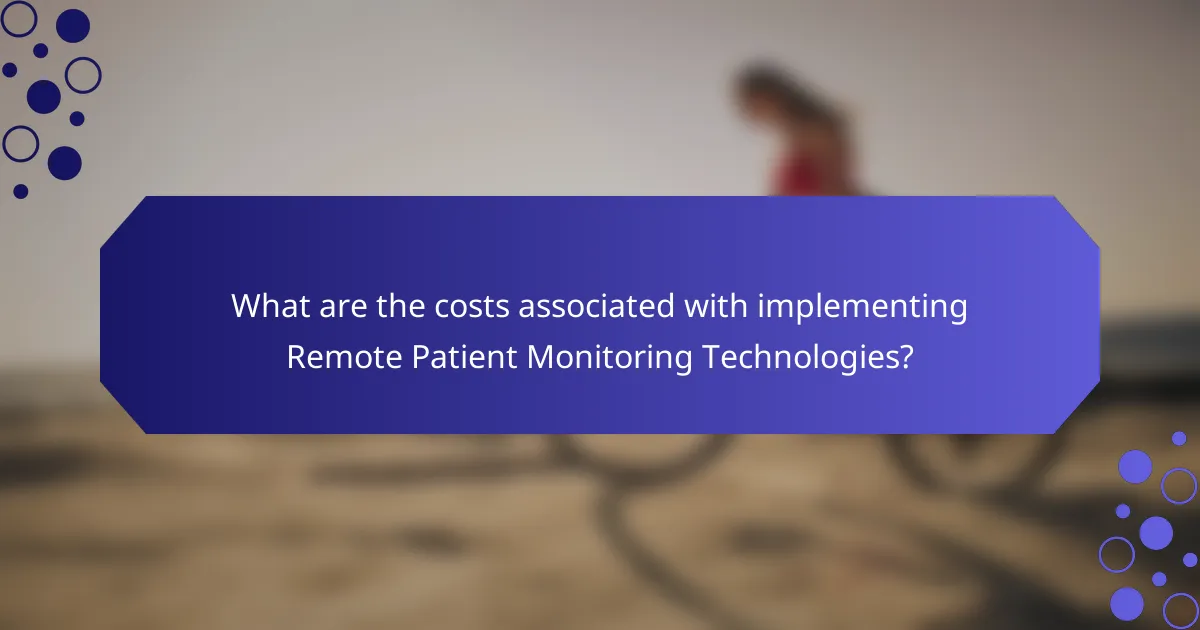
What are the costs associated with implementing Remote Patient Monitoring Technologies?
The costs associated with implementing Remote Patient Monitoring Technologies vary widely but generally include initial setup, device procurement, software licensing, and ongoing maintenance. Initial setup costs can range from $5,000 to $100,000 depending on the scale. Device costs average $100 to $300 per patient, while software licenses can be $20 to $200 monthly per user. Maintenance and training expenses add an additional 15% to 20% annually. Effective budgeting requires consideration of these factors to ensure successful implementation and patient satisfaction.
How do initial setup costs compare to ongoing operational expenses?
Initial setup costs for remote patient monitoring technologies are typically higher than ongoing operational expenses. Initial costs include equipment purchase, installation, and training, averaging around $5,000 to $10,000 per site. In contrast, ongoing expenses, such as software subscriptions and maintenance, range from $200 to $500 monthly. Over time, the lower operational costs can lead to significant savings, enhancing overall cost-effectiveness for healthcare providers.
What factors influence the overall cost of remote monitoring solutions?
Several factors influence the overall cost of remote monitoring solutions. Key elements include technology type, integration complexity, patient volume, data security requirements, and ongoing support services.
Technology type significantly impacts cost; advanced solutions with AI capabilities tend to be more expensive. Integration complexity arises when linking with existing healthcare systems, which can increase initial investment. Higher patient volumes often lead to reduced per-patient costs due to economies of scale. Data security requirements add to expenses, especially with stringent regulations. Lastly, ongoing support services, such as training and maintenance, contribute to the total cost.
How do costs vary across different regions or healthcare systems?
Costs for remote patient monitoring technologies vary significantly across regions and healthcare systems due to factors like infrastructure, labor costs, and reimbursement policies. For instance, urban areas often have higher costs than rural regions due to better technology availability and support services. Additionally, healthcare systems with integrated digital health solutions may experience lower overall costs through improved efficiency and patient outcomes. In contrast, systems lacking such integration might incur higher expenses due to fragmented care and increased hospital visits. As a result, understanding these regional differences is crucial for healthcare providers and policymakers when implementing remote monitoring solutions.
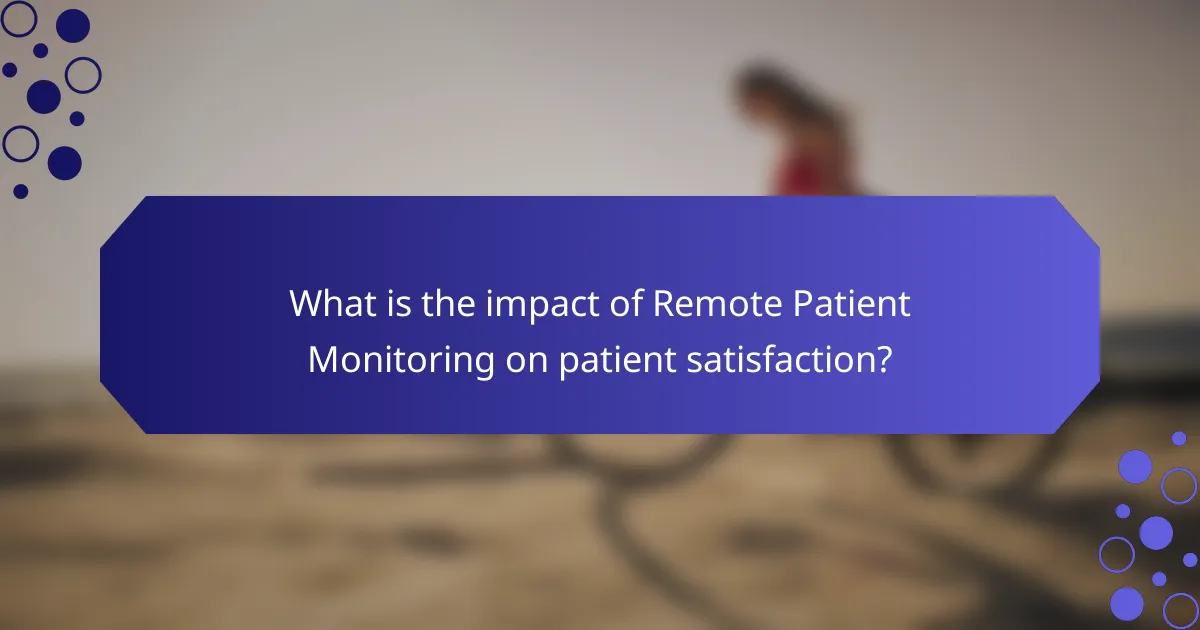
What is the impact of Remote Patient Monitoring on patient satisfaction?
Remote Patient Monitoring significantly enhances patient satisfaction by providing timely health data and personalized care. Patients feel more engaged and empowered in their health management. A study found that 70% of patients reported higher satisfaction levels due to improved communication with healthcare providers. Additionally, remote monitoring reduces hospital visits, leading to a more convenient healthcare experience. This technology fosters a sense of security, as patients can monitor their conditions from home, contributing to overall satisfaction.
How do patients perceive the effectiveness of remote monitoring?
Patients generally perceive remote monitoring as effective, enhancing their engagement and satisfaction. Studies indicate that 78% of patients report improved health outcomes due to consistent monitoring. The convenience of remote technologies reduces hospital visits, which contributes to positive perceptions. Additionally, personalized feedback from healthcare providers fosters a sense of support, further reinforcing patient satisfaction.
What feedback do patients provide regarding usability and accessibility?
Patients generally provide positive feedback regarding the usability and accessibility of remote patient monitoring technologies. Many appreciate the convenience of real-time health data tracking and the ease of communication with healthcare providers.
Common feedback highlights include user-friendly interfaces, which enhance patient engagement and adherence to monitoring protocols. Accessibility features, such as compatibility with various devices and platforms, are frequently praised.
However, some patients report challenges with technology familiarity and connectivity issues, which can hinder their experience. Overall, the effectiveness of these technologies in improving health outcomes contributes significantly to patient satisfaction.
How does patient engagement change with remote monitoring technologies?
Remote monitoring technologies significantly enhance patient engagement by providing continuous health data and personalized feedback. These technologies empower patients to actively participate in their care, leading to improved health outcomes and satisfaction. Studies indicate that remote monitoring can increase patient adherence to treatment plans by up to 50%. Additionally, patients report higher satisfaction levels due to real-time communication with healthcare providers, fostering a sense of connection and support. This shift towards proactive health management marks a unique advancement in patient care, making health monitoring more accessible and effective.
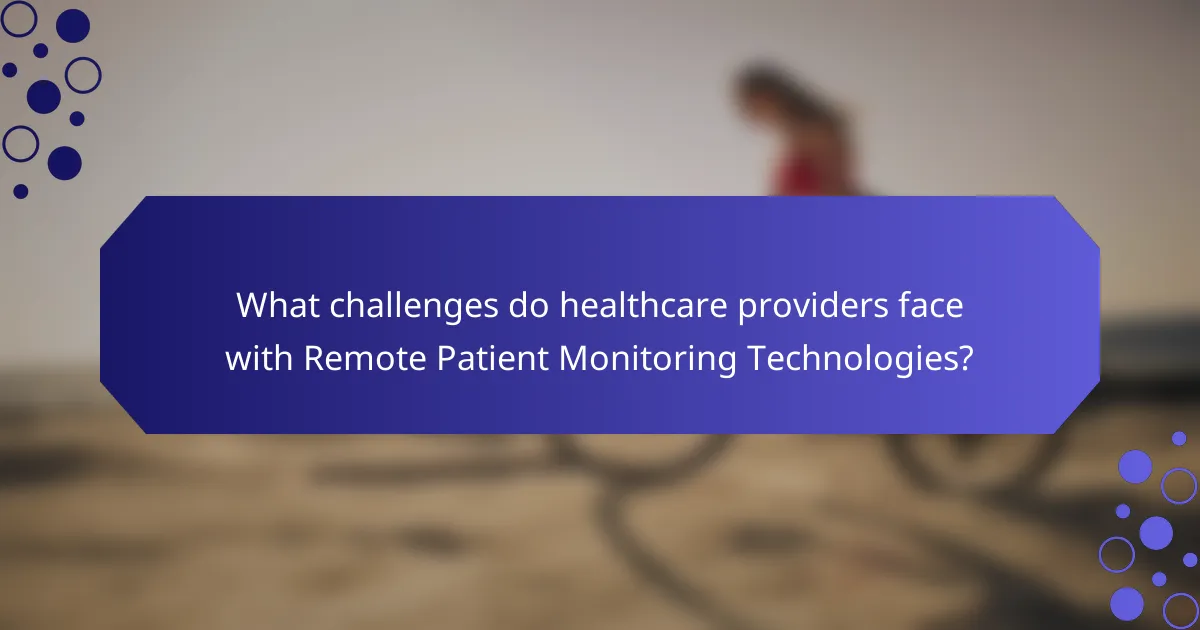
What challenges do healthcare providers face with Remote Patient Monitoring Technologies?
Healthcare providers face several challenges with Remote Patient Monitoring Technologies, including data security, integration with existing systems, and patient engagement. Data privacy concerns can hinder provider adoption, as sensitive health information must be protected. Integration issues arise when these technologies do not seamlessly connect with electronic health records, complicating workflow. Furthermore, ensuring patient engagement is crucial; without proper training and support, patients may struggle to use these technologies effectively. As a result, these factors can impact the overall effectiveness and satisfaction associated with remote monitoring solutions.
What are the common technical issues encountered?
Common technical issues in remote patient monitoring technologies include connectivity problems, data integration challenges, and device compatibility concerns. These issues can hinder the effectiveness of monitoring systems, leading to potential gaps in patient care. Connectivity issues often arise due to unstable internet connections, impacting real-time data transmission. Data integration challenges occur when systems fail to communicate effectively, resulting in fragmented patient information. Device compatibility concerns can limit the use of various monitoring devices, affecting overall patient satisfaction and technology adoption.
How do privacy and security concerns affect patient trust?
Privacy and security concerns significantly undermine patient trust in remote patient monitoring technologies. Patients worry about data breaches and unauthorized access to sensitive health information. Trust is essential for effective healthcare delivery; without it, patients may hesitate to share vital health data. Research indicates that 70% of patients express concerns about the security of their health information in digital formats. Strengthening data protection measures can enhance patient confidence and satisfaction with these technologies.
What barriers exist in integrating remote monitoring into existing healthcare systems?
Integration of remote monitoring into healthcare systems faces several barriers. Key challenges include interoperability issues, data security concerns, and resistance from healthcare providers.
Interoperability is crucial for seamless data exchange between different systems. Many existing healthcare IT systems lack the necessary compatibility, hindering effective integration. Data security is another significant barrier; concerns over patient privacy and the potential for data breaches can deter healthcare organizations from adopting these technologies.
Resistance from healthcare providers often stems from a lack of training and familiarity with new technologies. Additionally, there may be skepticism regarding the effectiveness and reliability of remote monitoring solutions, affecting overall acceptance.
Lastly, financial constraints can limit the ability of healthcare organizations to invest in the required infrastructure and ongoing support for remote monitoring technologies.
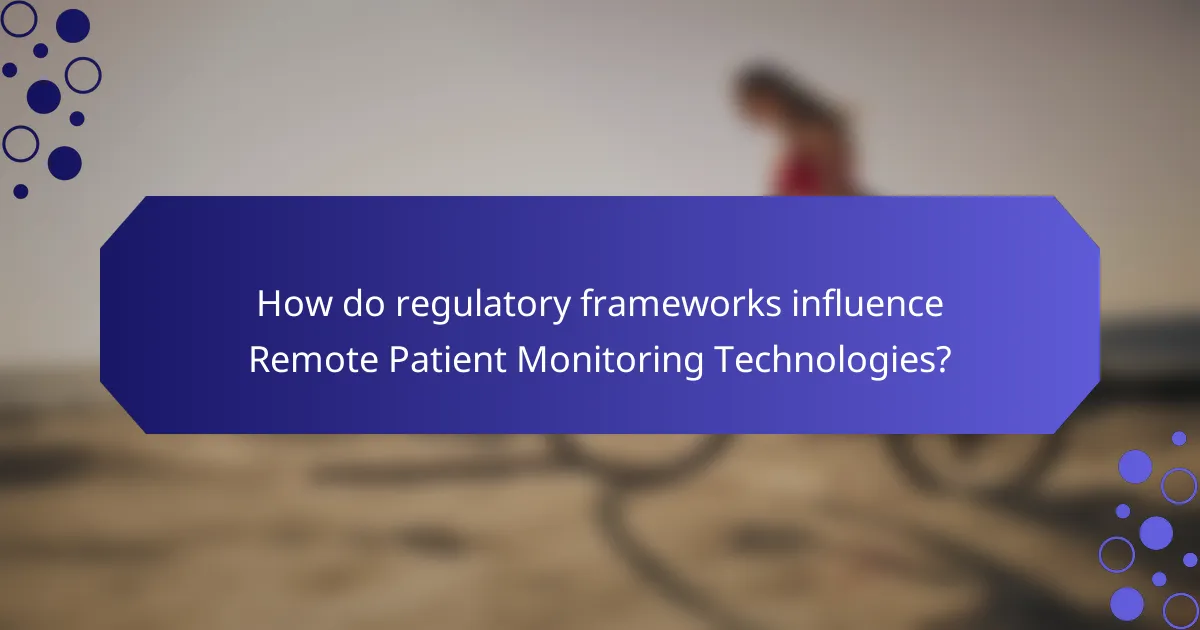
How do regulatory frameworks influence Remote Patient Monitoring Technologies?
Regulatory frameworks significantly shape Remote Patient Monitoring Technologies by ensuring safety, efficacy, and data privacy. These regulations influence technology adoption, reimbursement policies, and integration with healthcare systems. Compliance with standards, such as HIPAA in the U.S., enhances patient trust and satisfaction while guiding developers in creating secure and effective solutions. As a result, a well-regulated environment fosters innovation and encourages wider implementation of these technologies in patient care.
What are the key regulations governing remote monitoring in different regions?
Key regulations governing remote monitoring vary by region, focusing on patient privacy, data security, and technology standards. In the United States, HIPAA ensures patient confidentiality, while the FDA regulates device safety and efficacy. The European Union’s GDPR emphasizes data protection and patient consent, impacting how remote monitoring data is handled. In Canada, PIPEDA governs personal information protection, influencing remote patient monitoring practices. Each region’s regulations aim to balance innovation in healthcare technology with patient rights and safety.
How do compliance requirements impact technology adoption?
Compliance requirements significantly influence technology adoption in remote patient monitoring. They ensure that technologies meet safety, privacy, and efficacy standards, which can enhance patient trust and satisfaction. For example, adherence to HIPAA regulations in the U.S. mandates secure data handling, thus impacting the design and functionality of monitoring systems. As a result, technologies that align with compliance requirements are more likely to gain acceptance among healthcare providers and patients, ultimately improving health outcomes.
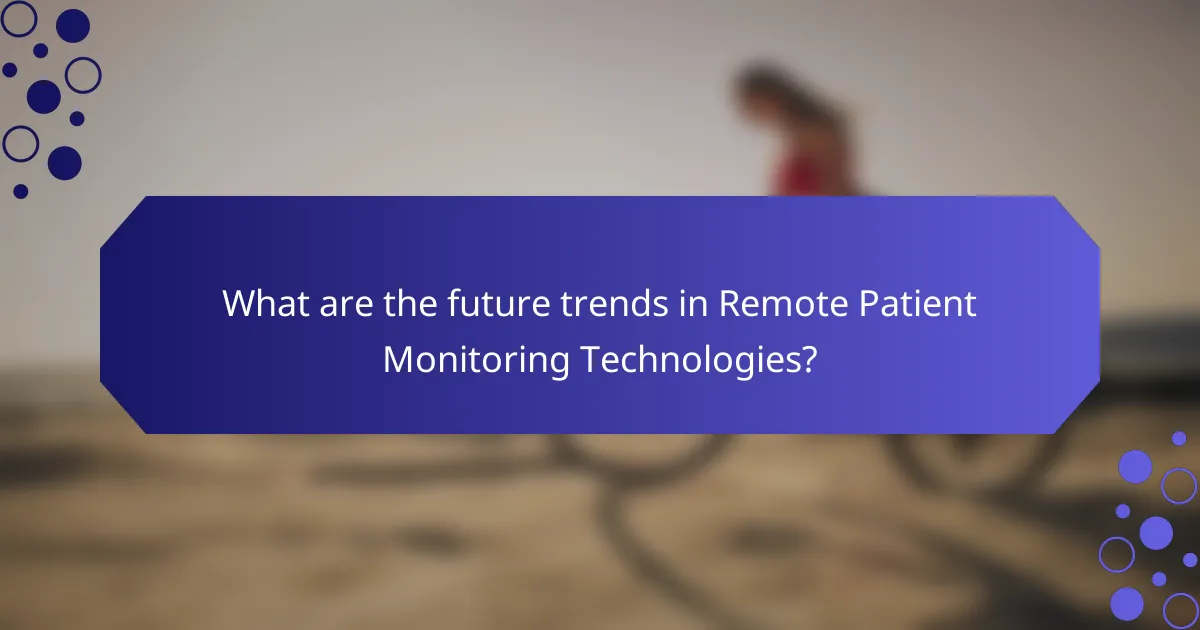
What are the future trends in Remote Patient Monitoring Technologies?
Remote Patient Monitoring Technologies are increasingly adopting AI, wearables, and telehealth integration. These trends enhance patient engagement, improve data accuracy, and reduce healthcare costs. AI algorithms predict patient deterioration, while wearables provide real-time health metrics. Telehealth platforms enable seamless communication between patients and providers. As a result, patient satisfaction is expected to rise due to personalized care and timely interventions.
How is artificial intelligence shaping remote monitoring solutions?
Artificial intelligence significantly enhances remote monitoring solutions by improving data accuracy and patient engagement. AI algorithms analyze vast amounts of health data, enabling real-time insights into patient conditions. This leads to timely interventions and personalized care plans, ultimately increasing patient satisfaction. Additionally, AI reduces operational costs by automating routine tasks, allowing healthcare professionals to focus on critical aspects of patient care. As a result, the integration of AI in remote patient monitoring transforms healthcare delivery and improves overall outcomes.
What innovations are expected to emerge in the next few years?
Remote patient monitoring technologies are expected to see significant advancements in the coming years. Innovations will likely focus on enhanced data analytics, improved wearable devices, and integration with artificial intelligence. These developments aim to increase effectiveness, reduce costs, and boost patient satisfaction. For instance, AI algorithms may analyze patient data in real-time, leading to better health outcomes. Additionally, cost-effective solutions will make remote monitoring more accessible, benefiting a larger population. Patient satisfaction is expected to improve as these technologies offer personalized care and convenience, allowing for better engagement in health management.
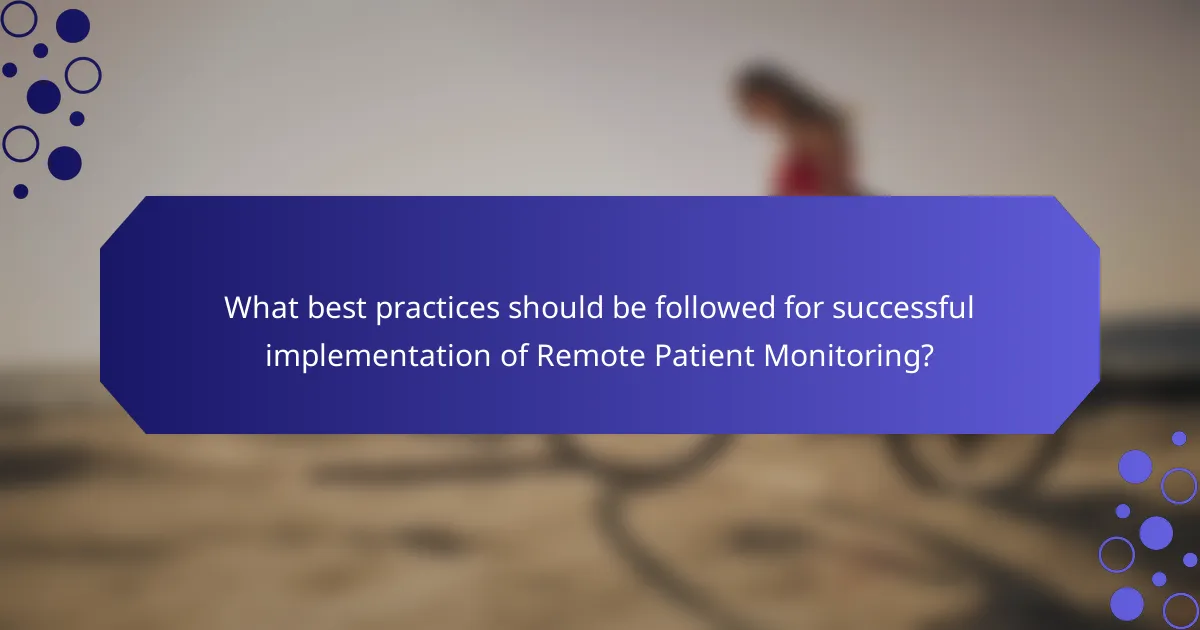
What best practices should be followed for successful implementation of Remote Patient Monitoring?
Successful implementation of Remote Patient Monitoring requires clear communication, robust technology integration, and patient engagement. Establish protocols for data security and privacy to build trust. Train healthcare staff on technology usage to enhance efficiency. Monitor patient feedback to improve services and adapt strategies as needed. Prioritize regular updates and system maintenance to ensure reliability.
How can healthcare providers optimize patient engagement with remote monitoring?
Healthcare providers can enhance patient engagement with remote monitoring by implementing user-friendly technologies and personalized communication strategies. Effective remote monitoring systems improve patient adherence to treatment plans and foster a sense of involvement in their health management.
Utilizing mobile health applications allows for real-time data sharing, which increases transparency and trust between patients and providers. This approach has been shown to boost patient satisfaction significantly, with studies indicating up to a 30% increase in engagement levels.
Incorporating educational resources and support networks within these platforms can empower patients, helping them understand their conditions better. As a result, patients feel more in control, leading to improved health outcomes.
Regular feedback and follow-up from healthcare providers further strengthen this engagement, ensuring patients remain motivated and informed throughout their care journey.
What strategies enhance the effectiveness of remote monitoring programs?
Implementing effective strategies enhances remote monitoring programs by improving patient engagement and data accuracy. Key strategies include utilizing user-friendly technology, providing continuous training for healthcare providers, and ensuring robust data security measures. Regular feedback loops between patients and providers foster trust and satisfaction. Additionally, integrating AI-driven analytics can optimize decision-making and personalize care plans, leading to better health outcomes.
What common pitfalls should be avoided during implementation?
Common pitfalls during the implementation of remote patient monitoring technologies include inadequate training, lack of patient engagement, and insufficient integration with existing systems. These factors can lead to decreased effectiveness and lower patient satisfaction.
1. Inadequate training for healthcare providers can result in improper use of technologies.
2. Lack of patient engagement may hinder compliance and reduce the benefits of monitoring.
3. Insufficient integration with existing health systems can create data silos, limiting access to crucial information.
4. Neglecting to address privacy concerns can lead to distrust among patients.
5. Failing to set clear objectives can result in misaligned expectations and ineffective outcomes.
